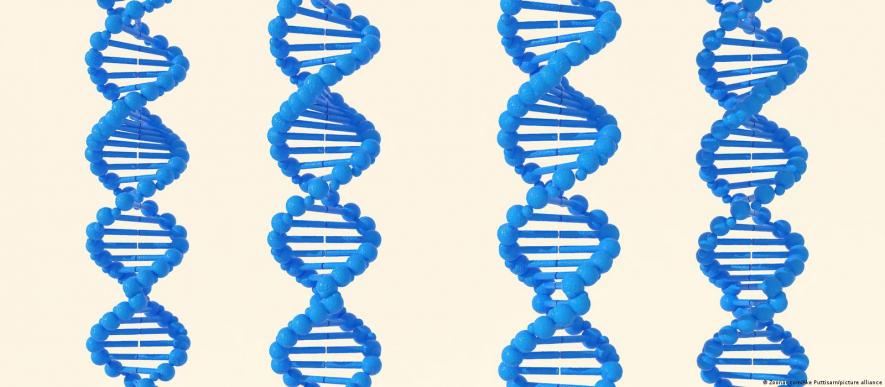Synthetic Human Genome: Need for Inclusiveness

A project to synthesise the human genome has been announced recently by a consortium of UK universities supported by the Wellcome Trust, which has more than £1 billion in funds. The Synthetic Human Genome Project (SynHG) aims to develop the means to construct human chromosomes—and eventually entire genomes—from scratch, starting with an initial investment of £10 million. Researchers from the University of Oxford, the University of Cambridge, Imperial College London, the University of Manchester, and the University of Kent are on this collaborative UK project.
The human genome consists of approximately three billion chemical "letters" (A, T, C, and G in humans). The genome is an organism's total DNA. To fit inside almost every cell in our body, this code is organised into 23 pairs of chromosomes that are securely wrapped around proteins. Instructions for constructing proteins, controlling development, and directing life itself are contained in this code.
The Back Story
Critically, this announcement did not happen in a vacuum. It was catalysed by a recent, pivotal breakthrough from a team at the J. Craig Venter Institute (JCVI), the University of Pennsylvania, and the University of Edinburgh. In March 2024, they announced they had finally solved a problem that had plagued synthetic biology for decades: the efficient construction of stable, single-copy Human Artificial Chromosomes (HACs).
Previous attempts to build HACs were thwarted by “multimerisation”— an uncontrollable process where the artificial chromosome would make numerous copies of itself inside a cell, rendering it useless for precise experimentation or therapy.
The JCVI-led team’s breakthrough was to build a much larger HAC from the outset, and comprised at least one million base pairs of DNA. This size, combined with expertise in transferring chromosomes from yeast into mammalian cells developed at JCVI, prevented multimerisation, resulting in a stable, single-copy HAC that is inherited correctly when human cells divide.
This success is a foundational leap. It provides synthetic biologists with a powerful, controllable tool for delivering large amounts of genetic information directly to the nucleus of a human cell. It is this very tool that makes the ambitions of the UK's SynHG project suddenly seem plausible.
The promise is revolutionary: virus-resistant tissues, an end to inherited mitochondrial diseases, and tailored cell therapies. But for readers who understand that science is never neutral, the announcement rings familiar alarm bells. In this brave new world of synthetic biology, who will this technology truly serve? The many, or the few?
To understand the reason for the question, it is necessary to realise what is going to be synthesised. The chromosomes are not simple strings; they are complex structures with protective caps, called telomeres, on their ends, just like the plastic tips on shoelaces. The chromosome has a pinched central region called a centromere that acts as an anchor during cell division.
For decades, the Holy Grail was just to read every letter in this library – or in technical language, 'sequence the genome'. This reading or sequencing effort began as a monumental public project.
The International Human Genome Project (HGP) was launched in 1990 by the US Department of Energy and the National Institute of Health at a cost of approximately $3 billion. The participants comprised public research institutes from the US, the UK, France, Germany, Japan and later China.
The project was a triumph of open, publicly-funded science. It operated under the Bermuda Principles, which mandated that all data be released freely within 24 hours—a radical commitment to collective ownership. Its progress was soon challenged by Craig Venter's private company, Celera Genomics, which aimed to sequence the genome faster and then patent hundreds of genes, locking humanity's common inheritance behind a paywall.
The resulting race ended in a tense, politically mediated truce, with a joint announcement by the then US President Bill Clinton and the then UK Prime Minister Tony Blair in 2000. But the HGP's 2003 declaration of "completion" was a milestone, not a finish line. The technologies of the time could only read the "paragraphs" of the genome; the repetitive, complex "sentences" in the telomeres and centromeres remained unreadable gaps.
The Human Genome Project was unable to complete the genome because nearly 8% of it—some 200 million letters—was hidden in these repetitive, structurally complex regions. It wasn't until March 2022 that the Telomere-to-Telomere (T2T) Consortium used advanced technologies to read every base pair from one end of each chromosome to the other.
Whom Does it Represent?
This scientific triumph exposed a deeper, more insidious problem: the myth of the "average" genome. The original HGP reference was an assembly of DNA from around 20 anonymous donors, with 70% of it coming from a single individual of mainly European ancestry. It was a single, incomplete story presented as a universal human one. The consequences of the bias have been to skew medical research and create unfortunate blind spots in global health.
The extent of this gap is starkly visible in India. While ambitious national projects, such as Genome India, have made significant strides—aiming to sequence 10,000 genomes to map the country's tremendous genetic diversity—the representation of Indian ancestry in global genomic databases remains a tiny sliver.
The IndiGen project has sequenced about 1,000 healthy Indian genomes, and Genome India has analysed around 10,000, uncovering some 135 million genetic variants. These efforts are crucial to uncover disease risks and drug responses unique to these populations. However, they remain a small fraction of global data. Many tribal or isolated groups are still unsampled, and their unique genetic architectures are absent from the global reference, meaning the benefits of precision medicine will continue to bypass them unless this is corrected.
There are efforts to overcome the bias at the international level. The Human Pangenome Reference Consortium is one of these initiatives whose goal is to inventory the variety of human genomes. This effort acknowledges that our DNA is a record that has traces of the DNA inherited through migrations and mixings and holds our history.
Read Also: Nobel for MicroRNA Work: Recognising Basic Science, Open Research
We now know, from sequencing ancient DNA, that modern humans outside of Africa inherited genes from Neanderthals and Denisovans. Intriguingly, one of these inherited genes, MUC19, is linked to the production of mucus, likely conferring an advantage in mucosal immunity—a tangible piece of our archaic past still active in our biology today.
For All the People
This brings us back to the new project to synthesise a human genome. Led by Professor Jason Chin, the SynHG consortium, which comprises only researchers in the UK, is starting modestly by aiming to synthesise a single human chromosome. There are many profound potential benefits if it succeeds. It is possible to make synthetic mitochondria to prevent inherited mitochondrial diseases. Human cell lines grown outside the body can now be engineered and used in humans for therapies. It will provide a deeper scientific understanding of how genome structure dictates function.
But the shadow of Celera and the inequities of past genomics loom large. Who will own these synthetic creations? Will they be patented? Will this technology, developed at immense cost, become a tool only for the wealthy, further entrenching global health disparities?
Remarkably, embedded within the SynHG consortium is a social science programme called "Care-full Synthesis" led by sociologist Joy Zhang at the University of Kent. Its mandate is explicitly political and inclusive: to consider societal priorities from across the Global South, include diverse perspectives in knowledge production, and explore the policies needed to ensure this research is applied only if and when communities desire it. This is not a project imposing a technology on the world. It is, in theory, a project that will create tools and, simultaneously, institute a global framework for their equitable use. It is an attempt to bake ethics and justice into the effort from the very beginning.
The promise of synthetic human genomes is no longer science fiction. The genome may be artificial, but the struggle over who controls it—who does the writing—is all too human. With its dedication to "Care-full Synthesis," the SynHG project is an attempt in the right direction. But the consortium that has taken the lead for the synthesis needs to be expanded. It needs to include researchers from institutions in the Global South. The data and outcomes have to be part of the commons. The venture of synthesising artificial human genomes has great potential and benefits, but whether it will overcome the bias and grow to benefit all will depend on the outcome of the tremendous commercial and political pressures that will unavoidably arise. What is important is that the story being written should encompass everyone.
The writer is a retired Professor, School of Biotechnology, Madurai Kamaraj University. He is in the All-India People’s Science Network. The views are personal.
Get the latest reports & analysis with people's perspective on Protests, movements & deep analytical videos, discussions of the current affairs in your Telegram app. Subscribe to NewsClick's Telegram channel & get Real-Time updates on stories, as they get published on our website.















